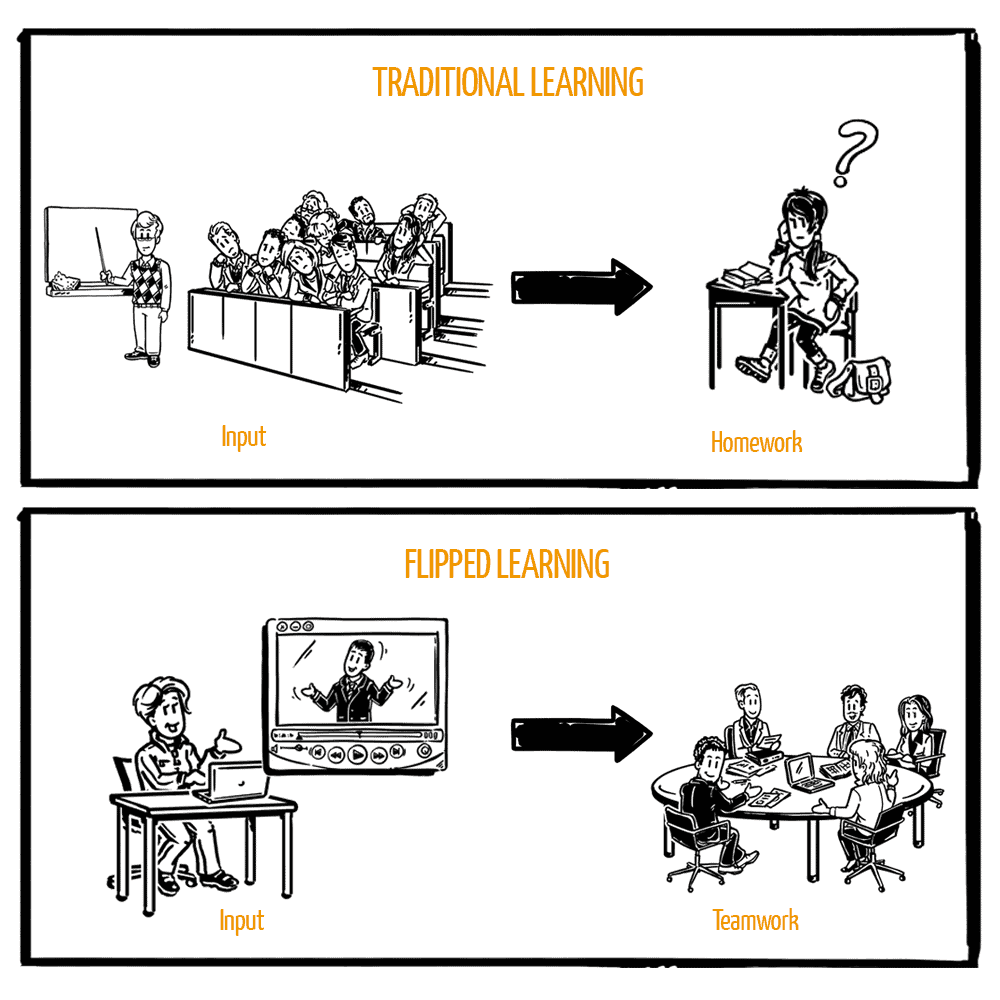New ways of teaching and learning: How flipped classrooms are doing it upside down
The way we consume information changed a lot – digital, mobile, time-independent.
The way we teach didn’t – frontal, linear, scheduled.
But one-size-fits-all doesn’t work with learning. Students are different but forced to learn the same way in the same amount of time.
Fortunately, there are already concepts which try to supersede the old-school mechanisms anyway. One of them wants to turn classrooms (and lecture halls) upside down and is therefore called the flipped classroom.
But wait! What does ‘flipped’ mean?
Well, the traditional way of teaching goes like this:
The teacher explains a new topic. At the end of the lesson there might be a few minutes left to do one exercise on this topic. As soon as the lesson is over, everybody leaves the classroom as fast as possible. If the teacher is lucky, they are barely able to cat-call what homework should be done.
During the following lesson, the teacher asks about the homework. Most students will say they tried, but weren’t able to complete it because they had some questions. The topic is then explained again in reference to the homework. So far, so classic.
The flipped classroom way goes like this:
Students learn about the new topic at home via video lessons. While in class, they will make use of what they’ve learned through exercises as well as the help of others and their teacher.
So within the flipped classroom, the teacher is more of a guide than the instructor, differentiating their role compared to the traditional way of learning.
Effects of a flipped classroom
Sounds cool so far, right? But what are the possible effects of a flipped classroom?
– Students are able to gather information at their own pace. If something is not understood, they are able to rewind the video. If something is going too fast, they are able to stop the video to first digest and reflect on the content before continuing.
– Classroom time is used in a more productive way.
– The teacher has much more time to coach students and work on practical tasks during the lessons instead of lecturing on theory and concepts.
– Students don’t give up so quickly when a solution is hard to find. At home, there is no one to ask for help, so students tend to lose motivation at a faster rate.
– Students become active learners instead of being listeners.
Teacher Wendy Roshan tried the flipped classroom and approves in an article which was published in the Washington Post: “Students become more independent learners because they work with one another more often in class and they get more individual attention. And they did better than ever.”
As experiences of the Clintondale High School, which flipped all of its classrooms, prove as well: All those effects lead up to better results as “the failure rate (…) in math dropped from 44 percent to 13 percent; in science, from 41 percent to 19 percent; and in social studies, from 28 percent to 9 percent.”
Another plus is the willingness of students to do their homework: “While only half of the students did traditional homework, 75 to 80 percent watch the videos.”
Also, teacher Kanchan Chellani told NBC about the ‘flipped experiences’: “Students now are scoring on average five points higher – the difference between a B+ and an A.”
Flipping practically and successfully
While all of this sounds great, there’s still some criteria to keep in mind for the successful practical implementation of a flipped classroom:
– Define objectives.
– Write an outline to make sure the online lessons have a logical structure.
– Keep the videos short (which means 3-15 minutes).
– Keep it rich in variety. Use images, infographics, and everything else to avoid monotony.
– Recap the most important points at the end.
– Give your students an opportunity and hint to note their questions so they won’t forget them until they are able to ask the teacher. Maybe even make it possible to ask questions online via chat or e-mail while watching the video.
– To make sure students are really learning the content of the online lesson, there should be a script with tasks to be fulfilled by the students while or after they have watched the video.
Ready to flip your classroom? Then start to create your own explainer video with mysimpleshow and make it a part of your own e-lesson.
Happy teaching, happy learning!

